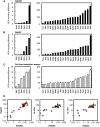Novel structural determinants in human SECIS elements modulate the translational recoding of UGA as selenocysteine
- PMID: 19651878
- PMCID: PMC2761289
- DOI: 10.1093/nar/gkp635
Novel structural determinants in human SECIS elements modulate the translational recoding of UGA as selenocysteine
Abstract
The selenocysteine insertion sequence (SECIS) element directs the translational recoding of UGA as selenocysteine. In eukaryotes, the SECIS is located downstream of the UGA codon in the 3'-UTR of the selenoprotein mRNA. Despite poor sequence conservation, all SECIS elements form a similar stem-loop structure containing a putative kink-turn motif. We functionally characterized the 26 SECIS elements encoded in the human genome. Surprisingly, the SECIS elements displayed a wide range of UGA recoding activities, spanning several 1000-fold in vivo and several 100-fold in vitro. The difference in activity between a representative strong and weak SECIS element was not explained by differential binding affinity of SECIS binding Protein 2, a limiting factor for selenocysteine incorporation. Using chimeric SECIS molecules, we identified the internal loop and helix 2, which flank the kink-turn motif, as critical determinants of UGA recoding activity. The simultaneous presence of a GC base pair in helix 2 and a U in the 5'-side of the internal loop was a statistically significant predictor of weak recoding activity. Thus, the SECIS contains intrinsic information that modulates selenocysteine incorporation efficiency.
Figures






References
-
- Rayman MP. Selenium in cancer prevention: a review of the evidence and mechanism of action. Proc. Nutr. Soc. 2005;64:527–542. - PubMed
-
- Patrick L. Selenium biochemistry and cancer: a review of the literature. Altern. Med. Rev. 2004;9:239–258. - PubMed
-
- Birringer M, Pilawa S, Flohe L. Trends in selenium biochemistry. Nat. Prod. Rep. 2002;19:693–718. - PubMed
-
- Rayman MP. The importance of selenium to human health. Lancet. 2000;356:233–241. - PubMed
-
- Kryukov GV, Castellano S, Novoselov SV, Lobanov AV, Zehtab O, Guigo R, Gladyshev VN. Characterization of mammalian selenoproteomes. Science. 2003;300:1439–1443. - PubMed
Publication types
MeSH terms
Substances
Grants and funding
LinkOut - more resources
Full Text Sources
Miscellaneous

